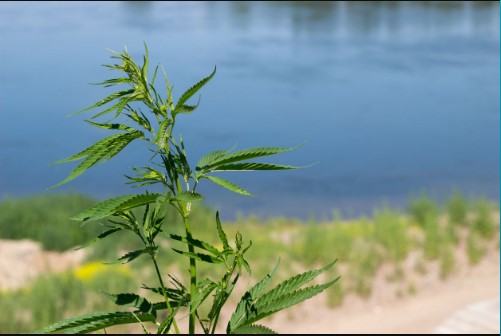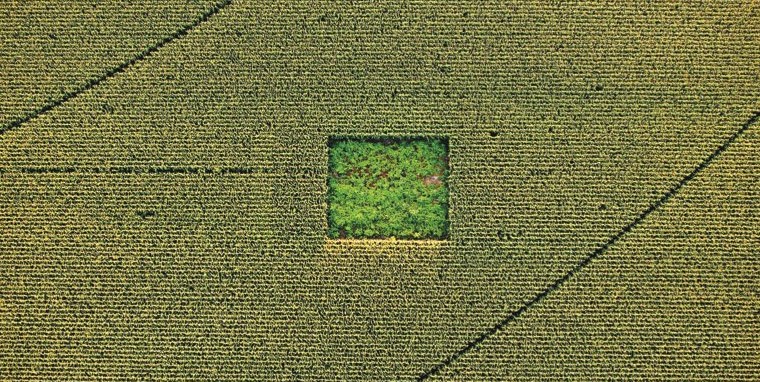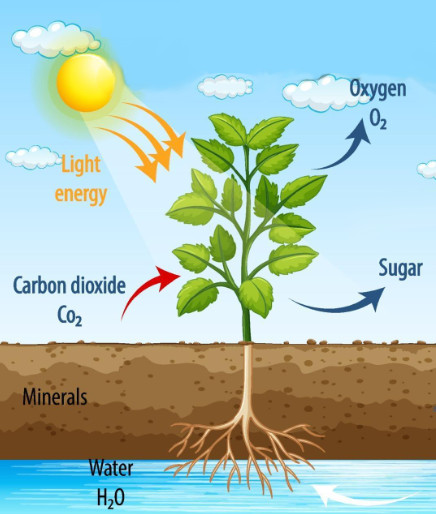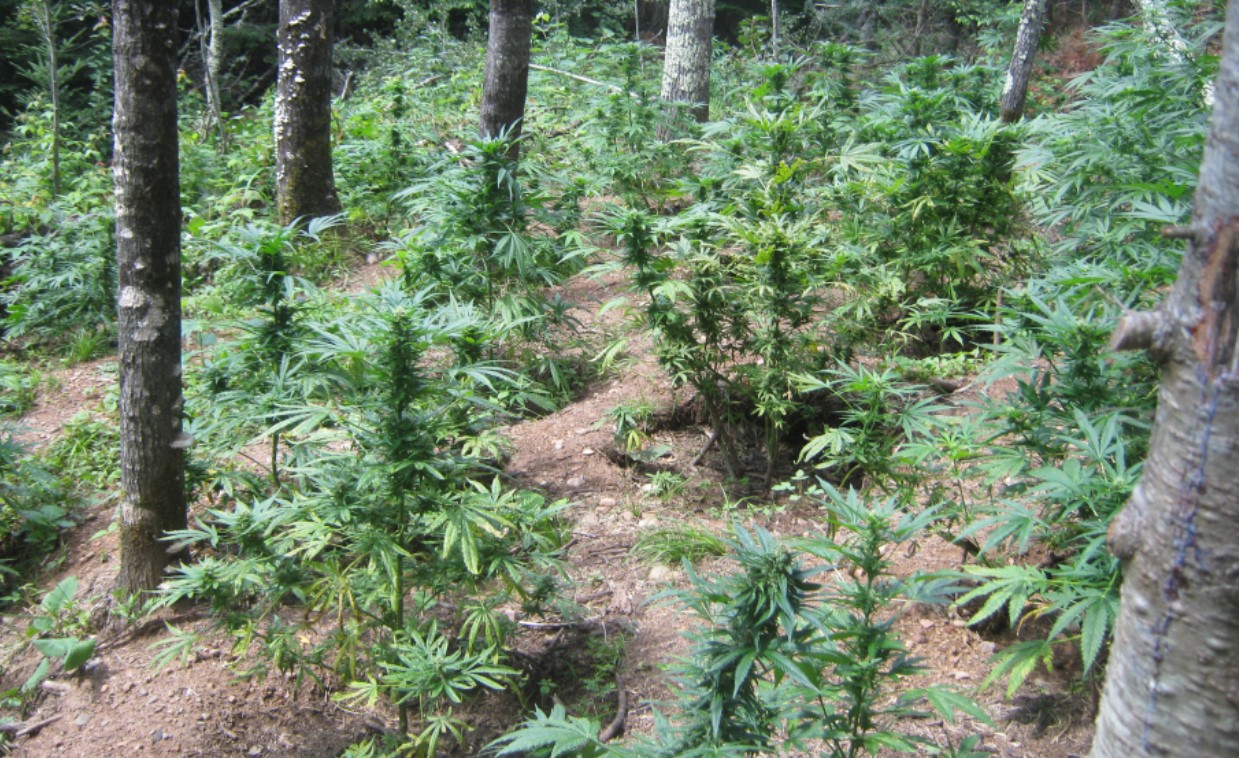Someone who consumes cannabis heavily only needs to grow five to seven large female cannabis plants for the whole year. Provided, of course, that they have been properly grown and are as healthy as possible. This means that if you choose the best spot to grow cannabis outdoors, you won’t need a particularly large amount of land to grow all the plants you want.
However, that doesn’t mean that usable growing space will be easy to find. There are many different things to think about when deciding where to grow your cannabis plants outdoors.
If you are looking for the perfect spot to grow cannabis outdoors, it should look something like this. A type of clearing that is secluded and close to a riverbank, with nutrient-rich soil that does not contain rocks and receives the sun all day.
Of course, the most important factor when choosing a location is always your own safety. The following topics are covered in this article.
Examples of outdoor growing places
Few people have the luxury of growing cannabis in their own garden, but that would be the best option most of the time. You’re never far from your plants, water them appropriately, and keep prying or suspicious eyes out of your garden as you see fit.
Despite this, the smell of cannabis can be quite strong. Therefore, keep the plants away from your neighbour’s fence.

Growing cannabis on the balcony
Like a garden, a balcony gives you an area to grow your cannabis seeds that you have easy access to. In contrast to a house garden, balconies can be seen from the street or even from neighbours who are themselves on a balcony.
You can use a matte plastic sheet to keep your plants out of sight but still get sun. The film can also reduce the spread of odour.
In the northern hemisphere, you should position your plants as south-facing as possible so that they get the most sun during the day.
Growing cannabis on a rooftop
On a roof terrace, your plants get sun all day, but odours and high winds can become a problem. Small amounts of wind are ideal for plants to develop strong trunks and stems, but constant wind conditions (like on a coast) are not good for cannabis plants.
If you want to grow in a windy environment, try to find or build a windbreak.
Growing cannabis in a forest
One of the best places to practice outdoor guerrilla cannabis cultivation is in the forest.
It’s always fun to hike through forests and try to find a spot with lots of sunlight, a nearby water source, and a long way from any trail or trail.
If there are no streams, you may be able to dig (sometimes only 1 meter deep) to find groundwater. In most cases, however, the forest soil is quite acidic (low pH ).
Pine forests and pastures have a problem with acidic soil. Sometimes it might be better to dig a hole and fill it with better, nutrient-enriched soil. You could also use 20-liter pots filled with good soil.

Cannabis cultivation on a riverbank
Along rivers or streams that host a slew of tall, green plants like stinging nettles, the soil in these locations is usually so wet that you don’t need to water the plants. You can add a nutrient solution ( fertilizer ) every month to improve the nutrient quality of the soil.
These places are also often difficult to reach. You may even have to swim across a river to get to your guerrilla cannabis garden, as chances are most other people won’t be willing to do so.
Cannabis cultivation in an open field
This might be a bad idea given the vastness and openness of a field, but if you camouflage your cannabis plants with other plants, it can be a good spot.
The plants get all the sun they need in a place that is easily accessible and difficult to tell which plants are due to the distance.
A heath usually has fairly acidic soil, but if the field has grass or other plants, cannabis should be able to grow there.
When you see nitrogen-loving nettles, the soil is full of nitrogen, one of the most important macronutrients for cannabis growth .
Despite this, the best practice is to plant your plants in a pot or a hole in the ground with good cannabis-grade soil .
Place the plants near blackberries and nettles so they won’t be noticeable to the casual viewer.
Cannabis cultivation in a cornfield
Although you probably don’t own a cornfield yourself, it’s an ideal location for growing cannabis. Growing the plants in the middle of corn gives your plants a wonderful amount of sun, all the water and nutrients they need and they are well hidden.
If you know another grower who has a cornfield and secretly grows cannabis there, ask them if you can grow your plants there too. Otherwise, doing guerrilla cannabis cultivation on someone else’s land is quite risky.
Even if you actually want to (or are able to) grow in a cornfield, your plants still have to be grown outside of the cornfield. You have to wait until late May or early July for the farmer to stop working the field with a tractor. The cannabis plants should be between 25 and 40 cm tall when transplanted into the field.
Plant them in the middle of the field, leaving a distance of 1 to 1.5 meters between plants. Memorize the rows your plants are in by marking the location or by measuring some other natural object. Within a few weeks, corn will grow quite tall, hiding your cannabis plants well.

How to find the best spots
First and foremost, you need to protect your location from being discovered. Once your cannabis plants are discovered by someone else, they are immediately useless as you will lose your entire harvest.
If you have them on your own property, make sure you protect yourself by placing them in a place where it’s easy for you to deny knowing the plants exist.
If the plants are in a sufficiently secluded spot on your property, you can probably claim you had no idea they grew there.
Some growers use homemade greenhouses to hide the plant species present there. While this reduces the chances of you being able to deny it, it also reduces the chances of your plants being discovered.
Although more exposed to prying eyes, public land is probably the safest choice. This can prevent the cannabis plants from being traced back to you. Even if your crop were discovered and destroyed, you would at least be safe from legal action.
Avoid being discovered by choosing a location wisely. Make sure they are in a place where there is no traffic ( e.g. on a hiking trail or other attraction) and where there is no hunting going on.
Also, keep a special eye out for places that someone might stumble across when looking for mushrooms and avoid such places. A mushroom picker would be more than happy to harvest your prized cannabis plants.
Another potential problem could be new building land. You wouldn’t be the first to pick a spot, prepare the ground and put valuable time and money into the preparation, and then come back a while later and see the land completely destroyed by tractors and construction equipment.
Some cannabis growers are particularly fortunate because they live in a place where the law allows cultivation, allowing them to focus on the more important aspects: soil, water, and light.
What do cannabis plants growing outdoors need?
Here is a shortlist of requirements for an outdoor cannabis cultivation site:
Sun
More sunlight correlates with taller plants and higher yields. If you’re growing in the shade, make sure your plants get a few hours of direct sun each day.

Water
Cannabis plants can thrive in most areas except those that are dry above average. If you have more water available, the plants can take up more nutrients. Streams, rivers or other nearby water sources are ideal. You can also bring your own water.
The right amount of wind
The gentle touch of a little breeze helps develop strong root systems, but too much wind can damage the cannabis plant. Choose a place that is not too windy.
Nutrient-rich soil
Nutrients are the lifeblood of cannabis plants. So try to find an area that has many other green plants growing. Cannabis will likely thrive in such a location.
Easy access
It’s reassuring and also important to see your plants at least once a month. You can tell if they have an insect or pest problem, nutrient deficiencies, lack of water, or whatever.
Keep hidden
Easy access to plants is good for you, but not for others. Try to deter thieves or would-be spies from your trail by not planting your cannabis plants near roads or other places frequented by people. Corn, sugarcane, and tomato plants can also camouflage cannabis.
You can also use the growth cycles of other plants to learn what to expect from your cannabis plants. You should study the growth behaviour of other summer plants such as corn or tomatoes. Corn is generally the best choice
This strategy gives you the opportunity to ask for tips (e.g. about corn or tomatoes) without having to explain that you are actually collecting the information to grow cannabis.
Since the harvest time for these other plants and cannabis is similar, information about other plants can be invaluable to you. You can gain helpful insight into growing climates and harvest times and should germinate your marijuana seeds around the same time as these other plants.
In addition to climate and harvest time, it can also help to talk to others about plants from the same growing season to get information on other factors that you may not have considered. These include topics such as rainfall and types of pests.
Of course, you can’t believe everything you hear, but such conversations might even help you find a good grow spot. Just make sure you’re discreet about it.
Using other Plants as Camouflage Foilage
Other plants can also be helpful just by being close to your plants. Tall and especially green plants help to hide cannabis plants. Many growers ( e.g. in urban areas) add flowers to their cannabis plants to make them resemble another native plant.
Although the flowers are only loosely attached, they are camouflaged enough from a distance to make this a popular method for rooftop growers. Sometimes it is enough to combine this floral technique with something else, e.g. B.tying down a few branches of the cannabis plants to cover up what you are actually growing in your garden.
Other growers intentionally use or place other plants around their cannabis plants. Green plants with lots of leaves, such as jasmine and spider plants, can work well for this. Bushes or bamboo are also used by growers to create a sort of living wall around their plants.
Be careful with these methods though: cannabis plants, which have to compete for sunlight with taller plants, spend all their precious energy getting very tall, which means they grow very rapidly and will soon outgrow the other plants. To avoid this, just make sure you don’t place the other plants too close to your cannabis. This is especially true if you are using the living wall technique.
All in all, you should educate yourself not only about cannabis plants in general but also about local and native plants.
Learn how and when they grow and use this to your advantage. It helps you grow healthy, strong cannabis plants and allows you to have a successful harvest without theft or loss of your plants. All information about your local system contributes to success. So start with the native plants.
Hide your plants
One of the best ways to camouflage cannabis is to plant it under trees or next to bushes.
Another tip is to make sure you only have a few plants in a certain area in case some of your plants get spotted. That way you don’t lose your entire harvest.
You can also bend and prune your cannabis plants to look like different species of plants, reducing the likelihood of detection. If you bend the stems and branches horizontally (downward), that’s even better: your plants will get more sun, which will increase the yield even more.
Although planting cannabis plants under trees is a great way to keep them well hidden, you need to make sure they get at least five hours of direct sunlight, plus much more indirect light. The more light there is for your plants, the more you will benefit from your harvest.
There are also growers who attach silk flowers (artificial flowers) to their cannabis plants for better camouflage.
Or they could also be placed close to similarly coloured and tall plants. Make sure, however, that these plants do not end their life before your plants do, as this would make your plants even more obvious.
The key is that your cannabis plants are not visible to people just looking around. However, your job is not done after you plant them.
Don’t be obvious
There are other steps you need to take:
- Change the route you take to your grow space every time you return there and cover your tracks. Leave no trace that might indicate that you (someone) was there: make the surroundings look as if nobody touched them.
- Make sure you park your car in a place where there are several cars nearby, even if it means you have to walk further.
- It helps if you have a water source close to the plants. Carrying tens of litres of water will look awfully flashy when someone sees you.
- Have a reasonable explanation for your on-site presence and even bring “props” to further support your story.
- For most people whose outdoor grow was in a really well-hidden place and yet got discovered, the only mistake was bragging about it to others.
All of these are equally important during the planning process before you start growing cannabis outdoors.
You might even want to try it on a smaller scale for your first growing season so you can be sure you can harvest the few plants you do grow.
Above all, be careful who you tell about your ventures. Even if you tell someone that you grow cannabis, you should always refrain from saying where the space you are growing is.
Protect yourself and your place
Security issues can vary significantly depending on geographic location. Even significantly within a country.
So how can you protect yourself in the country you live in? First and foremost, find out about local cannabis laws and the consequences of violating those laws.
In certain locations with stricter laws and penalties, the risk may not be worth it. Some states in the US, for example, have zero tolerance, which means the penalties, including imprisonment and heavy fines, are extreme.
Elsewhere, like in some European countries and some states in the US (California in particular), the penalty is highly dependent on how much you are growing/discovered.
In most cases, your plant will be taken away from you and you will be fined or reported, but that’s about it. You must do your own research and make an informed decision about what is right for you.
Either way, maintaining your safety is paramount. Last but not least, it protects your harvest from being discovered and taken away from you. The fewer people know about it, the less likely it is to be discovered. When in doubt, just don’t tell anyone.
Aerial surveillance and infrared photography are among the technologies used by American police forces in an attempt to find secret cannabis plantations. And apparently often with success.
The US government funds efforts to find and get rid of cannabis plants. Don’t let that intimidate you though: they mainly focus on much larger plantations that are much easier to find than a few plants for personal use.


I just couldn’t leave your site before suggesting behind the shed!